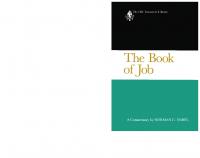Now My Eyes Have Seen You: Images of Creation and Evil in the Book of Job 9780830871414, 9780830826124
197 54 636KB
English Pages 208 Year 2002
Table of contents :
Series preface
Author's preface
Abbreviations
1. Speaking What is Right
The scope of this study
The approach taken
Is it a unitary work?
Varied readings of Job
The literary genre of Job
The poet's use of imagery
Myth and theology
The shape of this study
2. An Advocate in Heaven ?
The prose tale
Job 9:32-35
Job 16:18-22
Job 19:20-27
The third speech-cycle (chs. 22-31)
The Elihu speeches (chs. 32-37)
God and Job (38:1- 42:6)
The epilogue (42:7-16)
General comments
3. The Tragic Creator
'He also made the stars'
The tree of life
'Where can wisdom be found?'
'The world is charged with the granduer of God' (chs. 38-39)
4. The Raging Sea
Job 3:8
Job 7:12
Job 9
Job 26
Job 28
Job 38
The sea stories in the gospels
5. The Shadowlands
The significance of Job 3
The womb of the earth
The vast reaches of the underworld
The powers of darkness
6. Yahweh, Mot and Behemoth
God as tormentor
How the images relate to each other
The figure of Behemoth
7. The Ancient Prince of Hell
The scope of the study
A note on the prose tale
The significance of chapter 3
The significance of the rest of the poetic dialogue
The Elihu speech
8. Drawing Out Leviathan
The challenge (40:25-32; Eng. 41:1-8)
Overwhelming fear (41:1-4; Eng 41:9-12)
Description of the monster (41:5-21; Eng 41:13-29)
His habitat (41:22-26;Eng 41:31-34)
The other Leviathan passages
General comments
9. The Vision Glorious
Structure
Theological issues
Job and biblical theology
Appendix: Job and Cannanite Myth
The significance of Ugarit for Old Testament studies
The relevance of the Baal sagas
Theological significance
Bibliography
Index of modern authors
Index of scriptural references
Index of ancient sources
Series preface
Author's preface
Abbreviations
1. Speaking What is Right
The scope of this study
The approach taken
Is it a unitary work?
Varied readings of Job
The literary genre of Job
The poet's use of imagery
Myth and theology
The shape of this study
2. An Advocate in Heaven ?
The prose tale
Job 9:32-35
Job 16:18-22
Job 19:20-27
The third speech-cycle (chs. 22-31)
The Elihu speeches (chs. 32-37)
God and Job (38:1- 42:6)
The epilogue (42:7-16)
General comments
3. The Tragic Creator
'He also made the stars'
The tree of life
'Where can wisdom be found?'
'The world is charged with the granduer of God' (chs. 38-39)
4. The Raging Sea
Job 3:8
Job 7:12
Job 9
Job 26
Job 28
Job 38
The sea stories in the gospels
5. The Shadowlands
The significance of Job 3
The womb of the earth
The vast reaches of the underworld
The powers of darkness
6. Yahweh, Mot and Behemoth
God as tormentor
How the images relate to each other
The figure of Behemoth
7. The Ancient Prince of Hell
The scope of the study
A note on the prose tale
The significance of chapter 3
The significance of the rest of the poetic dialogue
The Elihu speech
8. Drawing Out Leviathan
The challenge (40:25-32; Eng. 41:1-8)
Overwhelming fear (41:1-4; Eng 41:9-12)
Description of the monster (41:5-21; Eng 41:13-29)
His habitat (41:22-26;Eng 41:31-34)
The other Leviathan passages
General comments
9. The Vision Glorious
Structure
Theological issues
Job and biblical theology
Appendix: Job and Cannanite Myth
The significance of Ugarit for Old Testament studies
The relevance of the Baal sagas
Theological significance
Bibliography
Index of modern authors
Index of scriptural references
Index of ancient sources

- Author / Uploaded
- Robert S. Fyall
- D. A. Carson
![Now You Know -- the Big Books Bundle : Now You Know Big Book of Answers / Now You Know Big Book of Answers 2 [1 ed.]
9781459724808](https://ebin.pub/img/200x200/now-you-know-the-big-books-bundle-now-you-know-big-book-of-answers-now-you-know-big-book-of-answers-2-1nbsped-9781459724808.jpg)







![The Book of Job [1]
9781905048021](https://ebin.pub/img/200x200/the-book-of-job-1-9781905048021.jpg)